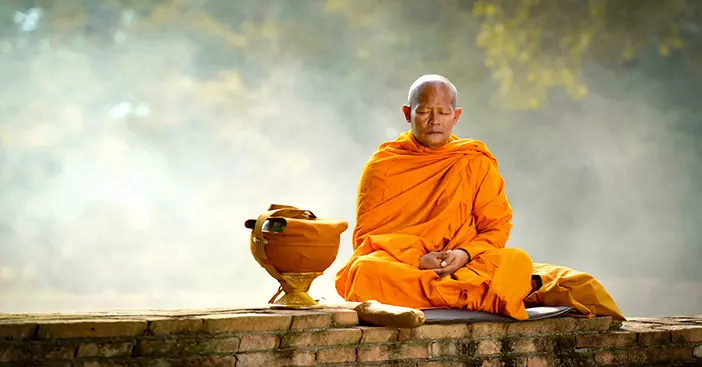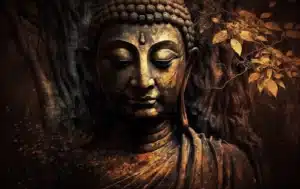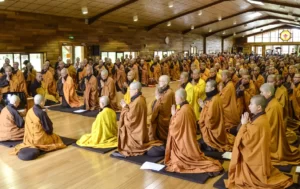Have you ever found yourself feeling overwhelmed by stress or struggling to quiet your racing thoughts? Venerable Thich Tri Hue told LotusBuddhas that most of the time during the day, we let our emotions take us from one mountain top to another – like a monkey jumping from one branch to another.
80% of our time during the day is spent struggling with thoughts and unpleasant emotions that come and go continuously. Rarely do we sit down and listen to the “little soul” inside us. To see what it needs and wants. We do not have the time to heal the wounds that society outside has caused to it.
If you also have this problem, meditation might be just the thing you need. Meditation is an ancient practice that has been used for thousands of years to help individuals cultivate inner peace, clarity of mind and emotional well-being.
Therefore, to balance emotions, LotusBuddhas recommends that you spend a few minutes each day meditating. Additionally, meditation also helps to increase positive emotions, reduce pain, cultivate discipline and patience.
What is Buddhist meditation?

In Buddhist practices, meditation holds a prominent and revered position. This ancient practice, rooted in the very core of Buddhist teachings, seeks to cultivate mental clarity and emotional tranquility, ultimately enabling the individual to transcend the boundaries of ordinary perception and attain spiritual awakening.
Meditation in Buddhism, often referred to as “bhavana” or mental cultivation, revolves around the development of two interrelated qualities: mindfulness (sati) and concentration (samadhi). The seamless fusion of these two aspects not only serves as a cornerstone for mental and emotional well-being but also paves the way for deeper insight into true nature of reality.
In Buddhist tradition, one encounters a plethora of meditation techniques, each tailored to suit the diverse propensities and inclinations of practitioners. Among these, two main methods reign supreme: Samatha (tranquility) meditation and Vipassana (insight) meditation.
LotusBuddhas will explain deeper into these two types of meditation in the following section. However, you have to remember that both Samatha and Vipassana are not mutually exclusive practices, but rather complementary aspects of a unified path. In fact, the Noble Buddha himself endorsed their harmonious coexistence, likening them to the two wings of a bird, which cannot soar to spiritual enlightenment without both wings.
As one embarks upon the journey of Buddhist meditation, a profound metamorphosis begins to unfold, illuminating the mind’s vast potential and revealing the luminous nature of consciousness. Freed from the shackles of ignorance, the practitioner transcends the cycle of birth and death (samsara), attains the ultimate goal of Buddhism: the blissful state of Nirvana.
History of meditation
The origins of meditation are challenging to pin down due to its ubiquitous nature across various cultures. The earliest documented records of meditation practices trace back to the Hindu traditions of Vedantism in India around 1500 BCE. This is seen in the ancient Indian texts, the Vedas, where meditation was described as a means to spiritual understanding. Similarly, practices comparable to meditation were found in Taoist China and Buddhist India around the 6th and 5th centuries BCE.
In Buddhism, origins of meditation are traced to the experiences of the historical Buddha, Siddhartha Gautama. Siddhartha, after renouncing his princely life, undertook arduous ascetic practices before realizing they did not lead to the cessation of suffering (dukkha). He then formulated the “Middle Way” – a path that avoids extremes of self-indulgence and self-mortification. This path led to his enlightenment (Bodhi) under the Bodhi tree in Bodhgaya, where he practiced mindfulness (smṛti) and insight (vipassanā) meditation.
Mahayana Buddhism, which emerged in the first century BCE, incorporated and developed new forms of meditation, adapting to the cultural and philosophical contexts of different regions, particularly China, Japan and Korea. Key Mahayana sutras like the Lotus Sutra and the Vimalakirti Sutra highlight meditation practices that emphasize not only personal liberation but also the bodhisattva ideal—seeking enlightenment for the benefit of all sentient beings. A prominent Mahayana meditation method is the practice of zazen, or “sitting meditation,” central to Zen Buddhism. Zen emphasizes direct, experiential realization through meditation and mindfulness in daily activities, often under the guidance of a master.
The Vajrayana or Tantric Buddhism, especially prominent in Tibet and parts of Nepal, Bhutan, and Mongolia, introduced complex visualization and mantra practices, further expanding the repertoire of Buddhist meditation. Deity yoga is one such practice, where practitioners visualize themselves as a Buddha or bodhisattva, aiming to cultivate their qualities. The unique practice of Dzogchen, or “Great Perfection,” seeks to recognize the inherent, primordially pure nature of mind.
Concurrently, early forms of meditative practices also appeared in Western religions. In Judaism, the practice of Kabbalah from as early as the 1st century BCE involves meditative methods to attain mystical insights. Early Christian monastic traditions incorporated contemplative practices, such as Hesychasm in Eastern Orthodoxy and the Lectio Divina in Western monasticism.
The Middle Ages saw the further development of these practices, particularly within the Sufi tradition of Islam, where meditation was used to attain a deeper comprehension of divine reality. Simultaneously, in the Eastern world, Zen Buddhism, emphasizing direct understanding through zazen or seated meditation, gained traction in China and Japan.
Meditation remained largely within the domain of religious and spiritual traditions until the 20th century, when its benefits began to be explored in the secular context. With the advent of globalization and increased intercultural exchange, Eastern meditative practices started gaining visibility in the Western world. This trend was marked by notable figures like Paramahansa Yogananda and Maharishi Mahesh Yogi, who introduced Yoga and Transcendental Meditation, respectively, to the West.
The latter half of the 20th century and the turn of the 21st century saw a dramatic increase in scientific interest in meditation. Inspired by the Mindfulness-Based Stress Reduction (MBSR) program developed by Jon Kabat-Zinn in 1979, which drew from traditional Buddhist practices, researchers began exploring the impact of meditation on physical and mental health. Numerous studies have since shown that meditation can contribute to reducing stress, anxiety, and depression, while enhancing attention, memory, and emotional well-being.
The contemporary landscape of meditation features a blend of traditional practices, secular adaptations, and scientific interpretations. From wellness apps offering guided meditation to mindfulness programs in schools and corporations, meditation has moved beyond its spiritual roots, becoming an integral part of modern health and wellness paradigms.
The different types of Buddhist meditation

Buddhism offers a variety of meditation techniques that are designed to help individuals develop mindfulness, concentration and insight. From the serene landscapes of Tibet to the bustling streets of Japan, various forms of meditation have emerged to guide practitioners on their spiritual journeys. Each technique offers a unique path towards enlightenment, providing a wealth of opportunities for self-discovery and growth.
1. Vipassana meditation (Insight)
Vipassana or insight meditation, is a cornerstone of Theravada Buddhism. Rooted in ancient teachings, this practice focuses on cultivating mindfulness and awareness of the present moment. By attentively observing the breath, bodily sensations, thoughts, and emotions, practitioners develop a deeper understanding of the impermanent and interconnected nature of reality. This heightened awareness ultimately leads to the dissolution of suffering and the attainment of inner peace.
2. Samatha meditation (Concentration)
Samatha meditation, often practiced alongside Vipassana, aims to foster concentration and tranquility of the mind. By focusing on a single point of reference, such as the breath or a visual object, practitioners cultivate unwavering attention and mental clarity. This state of deep absorption, known as “jhana” or “dhyana,” allows the meditator to transcend the confines of ordinary consciousness, paving the way for insight and spiritual awakening.
3. Metta meditation (Loving-Kindness)
Metta meditation, or loving-kindness meditation, is a practice that encourages the cultivation of benevolence, compassion, and empathy. By silently repeating phrases of goodwill towards oneself and others, practitioners foster an attitude of universal love and acceptance. This heart-centered practice serves to dissolve the barriers of anger, hatred, and prejudice, ushering in a profound sense of interconnectedness and harmony.
4. Zazen meditation (Sitting)
Zazen, the core practice of Zen Buddhism, is a form of seated meditation that emphasizes the cultivation of mindfulness, concentration, and insight. Sitting in a stable and upright posture, practitioners turn their attention to the breath, counting inhalations and exhalations to maintain focus. As thoughts and distractions arise, they are acknowledged without judgment and allowed to pass, like clouds drifting across the sky. The simplicity and discipline of Zazen practice encourage the development of a calm, present, and non-reactive state of mind.
5. Tonglen meditation (Taking and Giving)
Tonglen, a unique practice within Tibetan Buddhism, is a form of meditation that fosters compassion, altruism, and empathy. Visualizing the inhalation of others’ suffering and the exhalation of love and healing energy, practitioners cultivate an attitude of selflessness and interconnectedness. Through this transformative process, meditators purify their minds and develop the qualities of a bodhisattva – a being dedicated to the enlightenment and liberation of all sentient beings.
6. Koan meditation
A koan, a cryptic phrase or question, serves as the centerpiece of this contemplative practice. Often perplexing and confounding, koans defy conventional logic, forcing the meditator to abandon their reliance on intellectual understanding. By embracing the unknown, the practitioner embarks on an introspective odyssey, delving into the depths of their own consciousness to unearth the hidden treasures of insight and enlightenment.
The purpose of Buddhist meditation

The purpose of meditation practice in Buddhism is to develop a clear and focused mind, to cultivate qualities such as mindfulness, concentration and wisdom.
Meditation is not merely a passive activity but rather an active cultivation of mental qualities conducive to spiritual growth. Its primary aim is to foster awareness and concentration, nurturing the mind to transcend the mundane and attain a heightened state of consciousness. Through rigorous practice, a meditator gains insight into the true nature of reality, ultimately achieving the highest goal of Buddhism—Nirvana, the state of perfect peace and liberation from the cyclic existence of birth, suffering and death.
You should also know that meditation is not just for those seeking enlightenment. Even if you don’t want to achieve spiritual enlightenment, you can reap benefits of Buddhist meditation in many ways.
Think of it like a mental workout that can help you develop better emotional control, alleviate stress and anxiety, sharpen your focus, enhance your overall sense of inner harmony and contentment. It’s like a soothing balm for the mind, offering a sense of peace and tranquility that can help you navigate life’s challenges with greater ease and clarity. So, if you’re feeling frazzled and overwhelmed, take some time to meditate and allow yourself to find a calm center amid the chaos.
Stages of progress in Buddhist meditation
The progression of Buddhist meditation, particularly within the Theravada tradition, is often structured around key stages that meditators work through on their path to enlightenment. While the precise naming and number of these stages can vary among different sources and interpretations, the following outline provides a general map of the journey:
- Establishment of Virtue (Sila): This is the foundation upon which Buddhist practice is built. It involves adherence to ethical precepts such as refraining from causing harm, stealing, lying, sexual misconduct, and intoxication.
- Development of Concentration (Samatha): Samatha meditation aims to cultivate a calm and focused mind. The stages within this phase involve gradually overcoming the ‘five hindrances’ – sensual desire, ill-will, sloth and torpor, restlessness and worry, and doubt. As the meditator’s concentration deepens, they progress into a series of meditative absorptions known as ‘jhanas’.
- Four Material Jhanas (Rupajhanas): These are stages of deepening concentration and tranquility, each characterized by specific qualities such as rapture, happiness, and equanimity.
- First Jhana: The meditator experiences rapture and pleasure born from withdrawal from sensual pleasures and unwholesome states, along with initial thought and sustained thought.
- Second Jhana: The meditator experiences rapture and pleasure born of concentration, free from initial thought and sustained thought.
- Third Jhana: The meditator experiences equanimity, mindful, and fully aware, along with pleasure devoid of rapture.
- Fourth Jhana: The meditator experiences a state of pure equanimity and mindfulness, free from both pleasure and pain.
- Four Immaterial Jhanas (Arupajhanas): These advanced stages of concentration involve the transcending of material form.
- Sphere of Infinite Space: Consciousness transcends the limits of form and is said to pervade space infinitely.
- Sphere of Infinite Consciousness: Consciousness is perceived as infinite.
- Sphere of Nothingness: Perception of the absence of everything, or ‘nothingness’.
- Sphere of Neither-Perception-Nor-Non-Perception: This represents the limit of perceptual or cognitive experience.
- Cultivation of Insight (Vipassana): After the mind has been sufficiently stilled and concentrated through samatha, meditators begin the practice of vipassana, or insight meditation. The goal here is to directly perceive the three marks of existence – impermanence (anicca), suffering (dukkha) and non-self (anatta).
- Seven Stages of Purification: As outlined in the Path of Purification, these are stages through which insight deepens:
- Purification of Virtue (Sila-visuddhi): This involves the full embodiment of ethical conduct.
- Purification of Mind (Citta-visuddhi): This is achieved through the attainment of the jhanas.
- Purification of View (Ditthi-visuddhi): This involves correct understanding of the difference between the physical and mental phenomena of experience.
- Purification by Overcoming Doubt (Kankha-vitarana-visuddhi): This involves clear understanding of the causal relationships between physical and mental phenomena.
- Purification by Knowledge and Vision of What is Path and Not Path (Maggamagga-ñana-dassana-visuddhi): This involves clear understanding of what constitutes the path of liberation and what does not.
- Purification by Knowledge and Vision of the Way (Patipada-ñana-dassana-visuddhi): This involves experiential knowledge of the progress along the path.
- Purification by Knowledge and Vision (ñana-dassana-visuddhi): This is the final purification, leading to enlightenment or nirvana.
- Attainment of Enlightenment (Nirvana): This is the ultimate goal of Buddhist meditation, representing the complete cessation of suffering and liberation from the cycle of rebirth.
It should be noted that this framework represents a generalized structure and the actual progress of meditation may vary significantly depending on individual experiences and specific Buddhist traditions.
Benefits of practicing meditation

If you’re on the path to spiritual growth, inner peace and enlightenment, then you’ve probably already heard about the central role that meditation plays in Buddhism. And let me tell you, it’s not just some fancy technique – it’s an essential part of the journey.
Through meditation, you can cultivate mindfulness and awareness, which are crucial for understanding the true nature of reality and finding relief from suffering. But that’s just the tip of the iceberg. There are so many benefits of meditation in Buddhism that I could go on and on.
But here’s the thing – I can’t just spill all the secrets right away. Part of the beauty of meditation is discovering it for yourself. So, I’ll give you a little taste. Let’s just say that meditation can help you develop a deeper connection to yourself and the world around you. It can help you let go of negativity and embrace positivity. And it can help you tap into your inner wisdom and intuition.
But don’t just take my word for it. The best way to understand the power of meditation is to try it for yourself. Start small and be patient – it takes time and practice to see the results. And remember, meditation is a journey, not a destination.
1. Cultivating inner peace
Through the practice of meditation, the turbulent waters of the mind begin to settle, revealing a profound sense of calm and tranquility. As thoughts, emotions, and sensations arise and pass away, meditators develop the capacity to observe these phenomena without becoming entangled in them. This non-reactive awareness fosters a deep and abiding peace, enabling practitioners to navigate the challenges of life with grace and equanimity.
2. Enhancing mindfulness and concentration
Meditation trains the mind to remain anchored in the present moment, cultivating a heightened state of awareness known as mindfulness. As the meditator’s focus sharpens, they develop an unwavering concentration that extends far beyond the meditation cushion, imbuing everyday experiences with richness, depth and clarity.
3. Fostering emotional intelligence
By turning the lens of awareness inward, meditation invites practitioners to explore the landscape of their emotions with curiosity and non-judgment. This intimate encounter with the inner world cultivates emotional intelligence, fostering greater empathy, compassion and understanding towards oneself and others.
4. Unearthing insight and wisdom
As the veils of confusion and delusion fall away, meditation reveals the radiant nature of reality, shining a light on the interconnectedness and impermanence of all phenomena. This profound insight, or “prajna,” illuminates the path to enlightenment, guiding practitioners towards a life imbued with wisdom, compassion and freedom from suffering.
5. Reducing stress and anxiety
By teaching the mind to rest in the present moment, meditation offers a refuge from the stress and anxiety that often accompany modern life. By releasing the grip of worry and rumination, meditators cultivate a sense of inner calm and resilience that extends to every corner of their lives, fostering greater well-being and mental health.
6. Deepening spiritual awakening
At its core, meditation serves as a vehicle for spiritual awakening, guiding practitioners on the path to liberation and enlightenment. As the mind and heart open to the vast expanse of reality, the meditator begins to glimpse the true nature of existence, transcending the cycle of birth and death to attain a state of unbounded freedom and bliss.
Buddhist meditation practices aim to help individuals understand the concepts of non-self (Anatta) and impermanence (Anicca), leading to the realization of the true nature of reality and ultimately, enlightenment.
When you practice meditation diligently, you’re embarking on a journey of self-discovery and spiritual growth. And trust me, it’s a journey worth taking. You’ll uncover things about yourself that you never knew existed, and you’ll tap into a level of consciousness that’s hard to describe. Now, I know that might sound a little daunting. But don’t worry, you don’t have to be a master meditator to start experiencing the benefits. Just take it one breath at a time, and be patient with yourself. The journey may be long, but it’s oh-so-rewarding.
How to practice meditation for beginners

For many people, meditation provides a sense of peace and clarity that can be difficult to find in the hustle and bustle of daily life. If you are interested in meditation but are not sure where to start, here are a few tips to get you started on your journey.
1. Choose your space
Find a quiet, uncluttered space where you can sit undisturbed for the duration of your practice. Ideally, this spot should be well-ventilated, free from distractions, and infused with natural light. A peaceful and serene environment helps to calm your mind, priming it for meditation.
2. Set a schedule
Consistency is key when it comes to meditation. Choose a time when you can dedicate at least 10-15 minutes of uninterrupted focus. Early morning or late evening tend to be ideal, as they offer a natural sense of calm and tranquility. Commit to your practice and make it an essential part of your daily routine.
3. Posture and positioning
Sit cross-legged on a cushion, with your hips slightly elevated to maintain a natural curve in your spine. Alternatively, you can use a chair with your feet flat on the ground. Straighten your spine, relax your shoulders, and gently tuck in your chin. Allow your hands to rest on your knees or in your lap, whichever feels most comfortable.
4. Breathe deeply
Close your eyes and bring your awareness to your breath. Inhale deeply through your nose, filling your lungs and allowing your abdomen to expand. Exhale slowly, releasing the air through your nose and feeling your abdomen contract. Focus on your breath and its natural rhythm, anchoring your mind in the present moment.
5. Embrace the wandering mind
As you meditate, you may notice your mind wandering to various thoughts, feelings, or sensations. This is entirely natural. Acknowledge these distractions without judgment and gently guide your focus back to your breath. With each exhalation, imagine releasing any tension, anxiety, or preoccupations that may have arisen.
6. Mantras and visualization
If you find it challenging to focus on your breath alone, consider incorporating a mantra or visualization into your practice. Silently repeat a word or phrase, such as “peace” or “I am calm,” as you inhale and exhale. Alternatively, visualize a serene scene, like a beach or a forest, allowing your senses to become fully immersed in the experience.
7. Ease out of your practice
After 10-15 minutes, or when you feel ready, gently open your eyes and take a few moments to acclimate to your surroundings. Slowly stretch your limbs and take a few deep breaths, allowing your awareness to expand outward. Carry the calm and centered energy from your meditation into the rest of your day.
Just like any other skill, meditation takes practice and patience to master. Don’t let early difficulties discourage you. Keep at it and before you know it, you’ll begin to experience the many wonderful benefits that meditation has to offer.
Note: You can refer to how to practice meditation for beginners: https://lotusbuddhas.com/how-to-meditate-for-beginners.html
In as little as 10-15 minutes a day, meditation can be a delightful way to bring some much-needed peace and calm into your busy life. But, remember, your comfort is key. Avoid tight clothing that could distract you from your practice. Instead, opt for comfortable and breathable clothes, like what you’d wear to exercise or sleep. Trust us, it’s the smart choice. With these tips in mind, you’re sure to have a much more rewarding meditation practice.
Some famous Buddhist meditation centers around the world
Buddhist meditation centers have proliferated worldwide, offering practices that range from mindfulness to intensive Vipassana retreats. They provide sanctuary for learning and practicing Buddhist teachings and meditation techniques, often led by seasoned monastics or lay teachers. While numerous centers have made significant contributions to the global understanding and practice of Buddhism, several stand out for their influence and reputation.
- Wat Pah Nanachat, Thailand: Established by Ajahn Chah, one of the most renowned Thai Forest Tradition monks, this monastery provides teachings in English. It serves as an international training center for Theravada Buddhist monks and welcomes lay practitioners for meditation retreats.
- Spirit Rock Meditation Center, United States: Located in Northern California, this center is rooted in the Theravada tradition. It is one of the primary institutions that popularized mindfulness and Insight Meditation in the West. Notable teachers associated with Spirit Rock include Jack Kornfield, one of its co-founders, and a host of guest teachers from various Buddhist traditions.
- Insight Meditation Society, United States: Based in Massachusetts, this center offers residential retreats in Vipassana (Insight) and Metta (Loving-Kindness) meditation. It was co-founded by prominent teachers Sharon Salzberg, Jack Kornfield, and Joseph Goldstein in the 1970s, playing a pivotal role in the establishment of Vipassana and Metta practices in the Western world.
- Dhamma Giri, India: Situated in the state of Maharashtra, this is one of the world’s largest Vipassana meditation centers. It’s the main center of a global network offering courses in Vipassana meditation as taught by S. N. Goenka, who was instrumental in popularizing Vipassana in the 20th century.
- Plum Village, France: Established by the revered Vietnamese monk Thich Nhat Hanh, this center focuses on the practice of mindfulness and is the hub for the Order of Interbeing community. Thich Nhat Hanh’s teachings, known for their simplicity and accessibility, have been pivotal in introducing mindfulness to the West.
- Tassajara Zen Mountain Center, United States: Located in California and part of the San Francisco Zen Center, this is the first Zen monastery established in the Western world. It offers monastic training periods in the winter and guest retreats in the summer, emphasizing Soto Zen practice.
- Samye Ling, Scotland: Founded in 1967, this is the first Tibetan Buddhist center established in the West. It offers a range of courses in Tibetan Buddhism, mindfulness, yoga and more. Its activities also extend to charitable works around the world through the Rokpa Trust.
- Kagyu Samye Dzong, London: This is a branch of the Kagyu Samye Ling Monastery and offers teachings in the Kagyu lineage of Tibetan Buddhism. It provides a comprehensive schedule of classes, courses, and retreats.
- Upaya Zen Center, United States: Based in Santa Fe, New Mexico, and founded by Roshi Joan Halifax, Upaya is a Zen Buddhist practice and educational center. Upaya offers a range of programs, retreats, and workshops, including those focusing on the intersection of Buddhism with social service and engagement.
Each of these centers has significantly contributed to the spread of Buddhist teachings and meditation practices around the globe. They cater to both lay practitioners and monastics, offering opportunities for intensive practice, training, and study, as well as for retreat and spiritual rejuvenation.
Conclusion
Meditation in Buddhism is an indispensable practice for those who want to become enlightened. Because it will help practitioners develop wisdom, thoroughly understand the teachings of the Buddha to practice. As for ordinary people, with popular meditation methods being widely introduced, it will help improve physical and mental health, regain inner balance.
There are many successful entrepreneurs in the world such as Steve Jobs (former CEO of Apple), Jeff Weiner (CEO of LinkedIn), William Clay Ford Jr (President of Ford Motor Company),… have come to meditation to find a state of relaxation. and more informed before all important decisions. The special thing about meditation is that anyone can start practicing meditation without any problems and you can meditate anywhere.
Above is some information that LotusBuddhas would like to share so that you can understand what meditation is as well as the benefits that meditation brings to your life.
Note: If you want to learn more about meditation, you can visit our page of meditation knowledge for additional resources.







